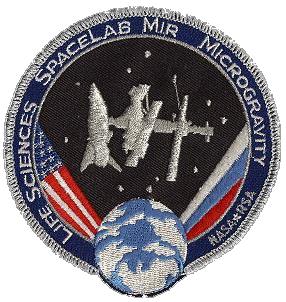Ellen S. Baker
Astronauts:
Command Pilot:
Robert L. Gibson
(Fifth Space Flight)
Pilot:
Charles J. Precourt
(Second Space Flight)
Gregory J. Harbaugh
(Third Space Flight) Mission Specialist 2:
(Third Space Flight)
Mission Specialist 3:
Bonnie J. Dunbar
(Fourth Space Flight) MIR Crew 1:
Anatoly Solovyev,
RKA EO-19
(First Space Flight) MIR Crew 2:
Norman E. Thagard,
EO-18
(Fifth Space Flight)
MIR Crew 3:
Nikolai Budarin,
RKA
EO-19
(First Space Flight) MIR Crew 4:
Vladmir Dezhurov,
EO-18
(First Space Flight) MIR Crew 5:
Gennady Strekalov,
EO-18
(Fifth Space Flight)
Spacelab Spacelab was a reusable laboratory used on certain spaceflights flown by the Space Shuttle. The laboratory comprised multiple components, including a pressurized module, an unpressurized carrier and other related hardware housed in the Shuttle's cargo bay. The components were arranged in various configurations to meet the needs of each spaceflight.
Spacelab components flew on 22 Shuttle missions between November 1983 and April 1998. Spacelab allowed scientists to perform experiments in microgravity in Earth orbit.
STS-71 marked a number of historic firsts in human spaceflight: 100th U.S. human space launch conducted from the Cape; first U.S. space shuttle-Russian Space Station Mir docking and joint on-orbit operations; largest spacecraft ever in orbit; and first on-orbit changeout of shuttle crew.
Docking occurred at 9 a.m. EDT, June 29, using R-Bar or Earth radius vector approach, with Atlantis closing in on Mir from directly below. R-bar approach allows natural forces to brake orbiter's approach more than would occur along standard approach directly in front of the space station; also, R-bar approach minimizes number of orbiter jet firings needed for approach. Manual phase of docking began with Atlantis about a half-mile below Mir, with Gibson at controls on aft flight deck. Stationkeeping performed when orbiter was about 250 feet from Mir, pending approval from Russian and U.S. flight directors to proceed. Gibson then maneuvered orbiter to a point at about 30 feet from Mir before beginning final approach to station. Closing rate was close to targeted 0.1 feet per second and closing velocity was approximately 0.107 feet per second at contact. Interface contact was nearly flawless: less than one inch lateral misalignment and an angular misalignment of less than 0.5-degrees per axis. Docking occurred about 216 nautical miles above Lake Baykal region of the Russian Federation. The Orbiter Docking System (ODS) with Androgynous Peripheral Docking System served as actual connection point to a similar interface on the docking port on Mir's Krystall module. ODS located in forward payload bay of Atlantis, performed flawlessly during docking sequence.
When linked, Atlantis and Mir formed largest spacecraft ever in orbit, with a total mass of almost one-half million pounds (about 225 tons) orbiting some 218 nautical miles above the Earth. After hatches on each side opened, STS-71 crew passed into Mir for welcoming ceremony. On same day, Mir 18 crew officially transferred responsibility for station to Mir 19 crew, and two crews switched spacecraft.
For next five days, about 100 hours total, joint U.S.-Russian operations conducted, including biomedical investigations, and transfer of equipment to and from Mir. Fifteen separate biomedical and scientific investigations were conducted, using Spacelab module installed in aft portion of Atlantis' payload bay, and covering seven different disciplines: cardiovascular and pulmonary functions; human metabolism; neuroscience; hygiene, sanitation and radiation; behavioral performance and biology; fundamental biology; and microgravity research. Mir 18 crew served as test subjects for investigations. Three Mir 18 crew members also carried out intensive program of exercise and other measures to prepare for re-entry into gravity environment after more than three months in space.
Numerous medical samples as well as disks and cassettes transferred to Atlantis from Mir, including more than 100 urine and saliva samples, about 30 blood samples, 20 surface samples, 12 air samples, several water samples and numerous breath samples taken from Mir 18 crew members. Also moved into orbiter was a broken Salyut-5 computer. Transferred to Mir were more than 1,000 pounds of water generated by the orbiter for waste system flushing and electrolysis; specially designed spacewalking tools for use by the Mir 19 crew during a spacewalk to repair a jammed solar array on the Spektr module; and transfer of oxygen and nitrogen from the shuttle's environmental control system to raise air pressure on the station, requested by Russians to improve Mir consumables margin.
Spacecraft undocked on July 4, following a farewell ceremony, with Mir hatch closing at 3:32 p.m. EDT, July 3 and hatch on Orbiter Docking System shut 16 minutes later. Gibson compared separation sequence to a "cosmic" ballet: Prior to Mir-Atlantis undocking, Mir 19 crew temporarily abandoned station, flying away from it in their Soyuz spacecraft so they could record images of Atlantis and Mir separating. Soyuz unlatched at 6:55 a.m. EDT, and Gibson undocked Atlantis from Mir at 7:10 a.m. EDT.
Returning crew of eight equaled largest crew (STS-61A, October 1985) in shuttle history. To ease their re-entry into gravity environment after more than 100 days in space, Mir 18 crew members Thagard, Dezhurov and Strekalov lay supine in custom-made recumbent seats installed prior to landing in orbiter middeck.
Inflight problems included a glitch with General Purpose Computer 4 (GPC 4), which was declared failed when it did not synchronize with GPC 1; subsequent troubleshooting indicated it was an isolated event, and GPC 4 operated satisfactorily for remainder of mission.
Spacelab Space Missions
Mission Specialist 1:
Study Research
Space Cosmology
Science Research
*
About
Science Research
Science Theories
Site Map
BookShelf
Desk
Copyright © by Nigel G Wilcox · All Rights reserved · E-Mail: ngwilcox100@gmail.com
Designed by Nigel G Wilcox
Powered By AM3L1A
Pages within this section: Spacelab 01-32
Spacelab C21-30
Spacelab 024 - STS-71
Mission Name:
Spacelab Mir
Sub-Menu
21
M
menu
22
23
24
25
26
27
8
29
30
28
>>>
D
SM










